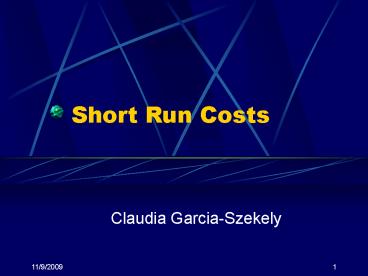Short Run Costs PowerPoint PPT Presentation
1 / 18
Title: Short Run Costs
1
Short Run Costs
- Claudia Garcia-Szekely
2
Introduction
- This chapter examines the costs of production.
- All firms incur costs as they make goods and
services. - These costs are a key determinant of a firms
production and pricing decisions.
3
Topics of Discussion
- Opportunity cost.
- Implicit and explicit costs.
- Economic and accounting costs.
- Fixed, variable and total costs.
4
What are Costs?
- All costs are opportunity costs.
- They represent what must be forgone to acquire
something.
5
How much does it cost to purchase a car?
The money that you send to the car company
All the things that you could have purchased with
that money
Explicit Cost
Interest you could have earned on that money
Implicit Cost
6
Opportunity Costs
Explicit
Implicit
The money that you did not make
Out of pocket expense
7
Consider a Small firm
Explicit Cost
The owner used 100,000 of his savings to open a
business.
100,000
Opportunity Cost
7 Interest lost
7,000
Implicit Cost
Owner works 48 hours a week to run the business.
No explicit Cost
Opportunity Cost
Salary lost in a year
200,000
Implicit Cost
8
Opportunity Costs
- Explicit costs are easy to see because a
payment is made. - Implicit costs are hidden, they represent a
cost even though no actual payment is made.
9
Production Costs
- Land.
- Labor
- Raw materials.
- Capital equipment .
10
Opportunity cost of Land
- If you pay rent for the land you use for your
business, you incur an explicit cost - The Rent you pay.
- If you own the land, you incur an implicit cost
- The Rent you are NOT earning because you have the
land tied up in production.
11
Labor
- Hired workers represent an explicit cost
- The wage you pay.
- The time you spend running your business
represents an implicit cost - The best salary you gave up.
12
Capital
- If you borrow money and pay interest on it you
incur an explicit cost - The interest you pay the bank on that loan.
- If you use your own money, you incur an implicit
cost - The interest you ARE NOT earning on that money.
13
Accountants only track Explicit Costs
- An Accountants job is to follow the money.
- Accounting costs include only explicit costs
(out-of-pocket expenses)
14
Economists track in both Implicit and Explicit
Costs
- Economists explain economic decisions.
- Economic decisions are explained by profits.
- Profits are explained by Costs and revenues
- Costs (implicit and explicit) must be taken into
consideration to determine profits.
15
Are you really making money?
- Profits Total Revenues Total Costs.
- Accounting Profits Total Revenues Explicit
Costs. - Economic Profits Total Revenues Explicit
Costs Implicit Costs.
16
Example 1
- A farmer gives piano lessons for 50 an hour. One
day she spends 10 hours planting 100 worth of
seeds on her farm. The seeds yield 200 worth of
crops - What are her explicit costs? ______________
- What are her implicit costs? ______________
- According to her accountant is she making a
profit? How much profit? ___________ - If you include also the hidden costsis she
making a profit? How much? ____________
100
500
Yes 200 100 100
No. 200 100 - 500 -400
17
Example 2
- Tom Borrows 40,000 from a bank to open an donut
shop. The interest on this loan is 5 a year. He
spends 25,000 on supplies (year) and pays
10,000/year in rent. He quits his 25,000/ year
job to work in his shop. - Toms accounting costs are
- ________________________
- Toms economic costs are
- _________________________
25,000 10,000 2,000 37,000
25,000 10,000 2,000 25,000 62,000
18
Example 3
- Use information from the previous example. Tom
sold 80,000 donuts during the year at a price of
50 cents per donut. - Toms total revenues are____________
- Toms profit according to his accountant was
_________________ - Toms economic profit was ____________
80,000 x 0,5 40,000
40,000 37,000 3,000
40,000 62,000 -22,000

